Yawen Cui
3DGeoDet: General-purpose Geometry-aware Image-based 3D Object Detection
Jun 11, 2025Abstract:This paper proposes 3DGeoDet, a novel geometry-aware 3D object detection approach that effectively handles single- and multi-view RGB images in indoor and outdoor environments, showcasing its general-purpose applicability. The key challenge for image-based 3D object detection tasks is the lack of 3D geometric cues, which leads to ambiguity in establishing correspondences between images and 3D representations. To tackle this problem, 3DGeoDet generates efficient 3D geometric representations in both explicit and implicit manners based on predicted depth information. Specifically, we utilize the predicted depth to learn voxel occupancy and optimize the voxelized 3D feature volume explicitly through the proposed voxel occupancy attention. To further enhance 3D awareness, the feature volume is integrated with an implicit 3D representation, the truncated signed distance function (TSDF). Without requiring supervision from 3D signals, we significantly improve the model's comprehension of 3D geometry by leveraging intermediate 3D representations and achieve end-to-end training. Our approach surpasses the performance of state-of-the-art image-based methods on both single- and multi-view benchmark datasets across diverse environments, achieving a 9.3 mAP@0.5 improvement on the SUN RGB-D dataset, a 3.3 mAP@0.5 improvement on the ScanNetV2 dataset, and a 0.19 AP3D@0.7 improvement on the KITTI dataset. The project page is available at: https://cindy0725.github.io/3DGeoDet/.
Analytic Subspace Routing: How Recursive Least Squares Works in Continual Learning of Large Language Model
Mar 17, 2025



Abstract:Large Language Models (LLMs) possess encompassing capabilities that can process diverse language-related tasks. However, finetuning on LLMs will diminish this general skills and continual finetuning will further cause severe degradation on accumulated knowledge. Recently, Continual Learning (CL) in Large Language Models (LLMs) arises which aims to continually adapt the LLMs to new tasks while maintaining previously learned knowledge and inheriting general skills. Existing techniques either leverage previous data to replay, leading to extra computational costs, or utilize a single parameter-efficient module to learn the downstream task, constraining new knowledge absorption with interference between different tasks. Toward these issues, this paper proposes Analytic Subspace Routing(ASR) to address these challenges. For each task, we isolate the learning within a subspace of deep layers' features via low-rank adaptation, eliminating knowledge interference between different tasks. Additionally, we propose an analytic routing mechanism to properly utilize knowledge learned in different subspaces. Our approach employs Recursive Least Squares to train a multi-task router model, allowing the router to dynamically adapt to incoming data without requiring access to historical data. Also, the router effectively assigns the current task to an appropriate subspace and has a non-forgetting property of previously learned tasks with a solid theoretical guarantee. Experimental results demonstrate that our method achieves near-perfect retention of prior knowledge while seamlessly integrating new information, effectively overcoming the core limitations of existing methods. Our code will be released after acceptance.
Semantic Shift Estimation via Dual-Projection and Classifier Reconstruction for Exemplar-Free Class-Incremental Learning
Mar 07, 2025


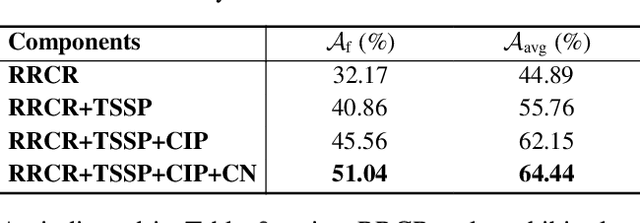
Abstract:Exemplar-Free Class-Incremental Learning (EFCIL) aims to sequentially learn from distinct categories without retaining exemplars but easily suffers from catastrophic forgetting of learned knowledge. While existing EFCIL methods leverage knowledge distillation to alleviate forgetting, they still face two critical challenges: semantic shift and decision bias. Specifically, the embeddings of old tasks shift in the embedding space after learning new tasks, and the classifier becomes biased towards new tasks due to training solely with new data, thereby hindering the balance between old and new knowledge. To address these issues, we propose the Dual-Projection Shift Estimation and Classifier Reconstruction (DPCR) approach for EFCIL. DPCR effectively estimates semantic shift through a dual-projection, which combines a learnable transformation with a row-space projection to capture both task-wise and category-wise shifts. Furthermore, to mitigate decision bias, DPCR employs ridge regression to reformulate classifier training as a reconstruction process. This reconstruction exploits previous information encoded in covariance and prototype of each class after calibration with estimated shift, thereby reducing decision bias. Extensive experiments demonstrate that, across various datasets, DPCR effectively balances old and new tasks, outperforming state-of-the-art EFCIL methods.
EPE-P: Evidence-based Parameter-efficient Prompting for Multimodal Learning with Missing Modalities
Dec 23, 2024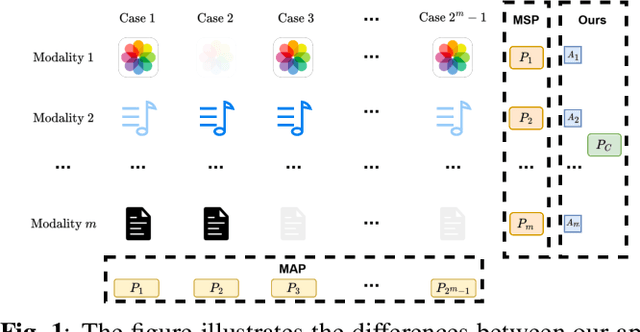
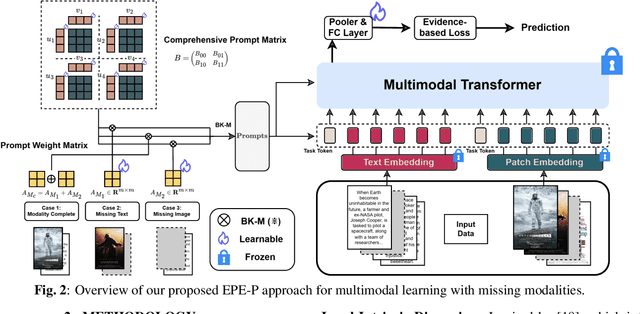
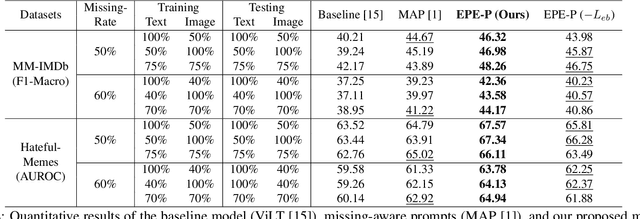
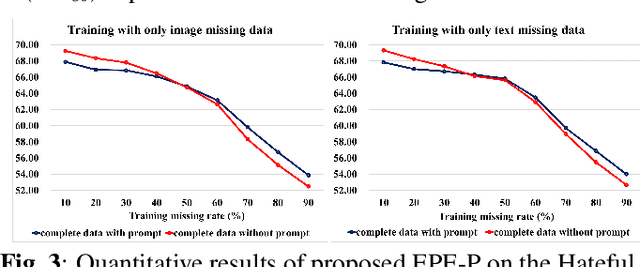
Abstract:Missing modalities are a common challenge in real-world multimodal learning scenarios, occurring during both training and testing. Existing methods for managing missing modalities often require the design of separate prompts for each modality or missing case, leading to complex designs and a substantial increase in the number of parameters to be learned. As the number of modalities grows, these methods become increasingly inefficient due to parameter redundancy. To address these issues, we propose Evidence-based Parameter-Efficient Prompting (EPE-P), a novel and parameter-efficient method for pretrained multimodal networks. Our approach introduces a streamlined design that integrates prompting information across different modalities, reducing complexity and mitigating redundant parameters. Furthermore, we propose an Evidence-based Loss function to better handle the uncertainty associated with missing modalities, improving the model's decision-making. Our experiments demonstrate that EPE-P outperforms existing prompting-based methods in terms of both effectiveness and efficiency. The code is released at https://github.com/Boris-Jobs/EPE-P_MLLMs-Robustness.
Prior-free Balanced Replay: Uncertainty-guided Reservoir Sampling for Long-Tailed Continual Learning
Aug 27, 2024Abstract:Even in the era of large models, one of the well-known issues in continual learning (CL) is catastrophic forgetting, which is significantly challenging when the continual data stream exhibits a long-tailed distribution, termed as Long-Tailed Continual Learning (LTCL). Existing LTCL solutions generally require the label distribution of the data stream to achieve re-balance training. However, obtaining such prior information is often infeasible in real scenarios since the model should learn without pre-identifying the majority and minority classes. To this end, we propose a novel Prior-free Balanced Replay (PBR) framework to learn from long-tailed data stream with less forgetting. Concretely, motivated by our experimental finding that the minority classes are more likely to be forgotten due to the higher uncertainty, we newly design an uncertainty-guided reservoir sampling strategy to prioritize rehearsing minority data without using any prior information, which is based on the mutual dependence between the model and samples. Additionally, we incorporate two prior-free components to further reduce the forgetting issue: (1) Boundary constraint is to preserve uncertain boundary supporting samples for continually re-estimating task boundaries. (2) Prototype constraint is to maintain the consistency of learned class prototypes along with training. Our approach is evaluated on three standard long-tailed benchmarks, demonstrating superior performance to existing CL methods and previous SOTA LTCL approach in both task- and class-incremental learning settings, as well as ordered- and shuffled-LTCL settings.
TRRG: Towards Truthful Radiology Report Generation With Cross-modal Disease Clue Enhanced Large Language Model
Aug 22, 2024



Abstract:The vision-language modeling capability of multi-modal large language models has attracted wide attention from the community. However, in medical domain, radiology report generation using vision-language models still faces significant challenges due to the imbalanced data distribution caused by numerous negated descriptions in radiology reports and issues such as rough alignment between radiology reports and radiography. In this paper, we propose a truthful radiology report generation framework, namely TRRG, based on stage-wise training for cross-modal disease clue injection into large language models. In pre-training stage, During the pre-training phase, contrastive learning is employed to enhance the ability of visual encoder to perceive fine-grained disease details. In fine-tuning stage, the clue injection module we proposed significantly enhances the disease-oriented perception capability of the large language model by effectively incorporating the robust zero-shot disease perception. Finally, through the cross-modal clue interaction module, our model effectively achieves the multi-granular interaction of visual embeddings and an arbitrary number of disease clue embeddings. This significantly enhances the report generation capability and clinical effectiveness of multi-modal large language models in the field of radiology reportgeneration. Experimental results demonstrate that our proposed pre-training and fine-tuning framework achieves state-of-the-art performance in radiology report generation on datasets such as IU-Xray and MIMIC-CXR. Further analysis indicates that our proposed method can effectively enhance the model to perceive diseases and improve its clinical effectiveness.
DAAD: Dynamic Analysis and Adaptive Discriminator for Fake News Detection
Aug 20, 2024Abstract:In current web environment, fake news spreads rapidly across online social networks, posing serious threats to society. Existing multimodal fake news detection (MFND) methods can be classified into knowledge-based and semantic-based approaches. However, these methods are overly dependent on human expertise and feedback, lacking flexibility. To address this challenge, we propose a Dynamic Analysis and Adaptive Discriminator (DAAD) approach for fake news detection. For knowledge-based methods, we introduce the Monte Carlo Tree Search (MCTS) algorithm to leverage the self-reflective capabilities of large language models (LLMs) for prompt optimization, providing richer, domain-specific details and guidance to the LLMs, while enabling more flexible integration of LLM comment on news content. For semantic-based methods, we define four typical deceit patterns: emotional exaggeration, logical inconsistency, image manipulation, and semantic inconsistency, to reveal the mechanisms behind fake news creation. To detect these patterns, we carefully design four discriminators and expand them in depth and breadth, using the soft-routing mechanism to explore optimal detection models. Experimental results on three real-world datasets demonstrate the superiority of our approach. The code will be available at: https://github.com/SuXinqi/DAAD.
FusionMamba: Dynamic Feature Enhancement for Multimodal Image Fusion with Mamba
Apr 15, 2024Abstract:Multi-modal image fusion aims to combine information from different modes to create a single image with comprehensive information and detailed textures. However, fusion models based on convolutional neural networks encounter limitations in capturing global image features due to their focus on local convolution operations. Transformer-based models, while excelling in global feature modeling, confront computational challenges stemming from their quadratic complexity. Recently, the Selective Structured State Space Model has exhibited significant potential for long-range dependency modeling with linear complexity, offering a promising avenue to address the aforementioned dilemma. In this paper, we propose FusionMamba, a novel dynamic feature enhancement method for multimodal image fusion with Mamba. Specifically, we devise an improved efficient Mamba model for image fusion, integrating efficient visual state space model with dynamic convolution and channel attention. This refined model not only upholds the performance of Mamba and global modeling capability but also diminishes channel redundancy while enhancing local enhancement capability. Additionally, we devise a dynamic feature fusion module (DFFM) comprising two dynamic feature enhancement modules (DFEM) and a cross modality fusion mamba module (CMFM). The former serves for dynamic texture enhancement and dynamic difference perception, whereas the latter enhances correlation features between modes and suppresses redundant intermodal information. FusionMamba has yielded state-of-the-art (SOTA) performance across various multimodal medical image fusion tasks (CT-MRI, PET-MRI, SPECT-MRI), infrared and visible image fusion task (IR-VIS) and multimodal biomedical image fusion dataset (GFP-PC), which is proved that our model has generalization ability. The code for FusionMamba is available at https://github.com/millieXie/FusionMamba.
Animal3D: A Comprehensive Dataset of 3D Animal Pose and Shape
Aug 22, 2023



Abstract:Accurately estimating the 3D pose and shape is an essential step towards understanding animal behavior, and can potentially benefit many downstream applications, such as wildlife conservation. However, research in this area is held back by the lack of a comprehensive and diverse dataset with high-quality 3D pose and shape annotations. In this paper, we propose Animal3D, the first comprehensive dataset for mammal animal 3D pose and shape estimation. Animal3D consists of 3379 images collected from 40 mammal species, high-quality annotations of 26 keypoints, and importantly the pose and shape parameters of the SMAL model. All annotations were labeled and checked manually in a multi-stage process to ensure highest quality results. Based on the Animal3D dataset, we benchmark representative shape and pose estimation models at: (1) supervised learning from only the Animal3D data, (2) synthetic to real transfer from synthetically generated images, and (3) fine-tuning human pose and shape estimation models. Our experimental results demonstrate that predicting the 3D shape and pose of animals across species remains a very challenging task, despite significant advances in human pose estimation. Our results further demonstrate that synthetic pre-training is a viable strategy to boost the model performance. Overall, Animal3D opens new directions for facilitating future research in animal 3D pose and shape estimation, and is publicly available.
Hyperbolic Face Anti-Spoofing
Aug 17, 2023



Abstract:Learning generalized face anti-spoofing (FAS) models against presentation attacks is essential for the security of face recognition systems. Previous FAS methods usually encourage models to extract discriminative features, of which the distances within the same class (bonafide or attack) are pushed close while those between bonafide and attack are pulled away. However, these methods are designed based on Euclidean distance, which lacks generalization ability for unseen attack detection due to poor hierarchy embedding ability. According to the evidence that different spoofing attacks are intrinsically hierarchical, we propose to learn richer hierarchical and discriminative spoofing cues in hyperbolic space. Specifically, for unimodal FAS learning, the feature embeddings are projected into the Poincar\'e ball, and then the hyperbolic binary logistic regression layer is cascaded for classification. To further improve generalization, we conduct hyperbolic contrastive learning for the bonafide only while relaxing the constraints on diverse spoofing attacks. To alleviate the vanishing gradient problem in hyperbolic space, a new feature clipping method is proposed to enhance the training stability of hyperbolic models. Besides, we further design a multimodal FAS framework with Euclidean multimodal feature decomposition and hyperbolic multimodal feature fusion & classification. Extensive experiments on three benchmark datasets (i.e., WMCA, PADISI-Face, and SiW-M) with diverse attack types demonstrate that the proposed method can bring significant improvement compared to the Euclidean baselines on unseen attack detection. In addition, the proposed framework is also generalized well on four benchmark datasets (i.e., MSU-MFSD, IDIAP REPLAY-ATTACK, CASIA-FASD, and OULU-NPU) with a limited number of attack types.
 Add to Chrome
Add to Chrome Add to Firefox
Add to Firefox Add to Edge
Add to Edge